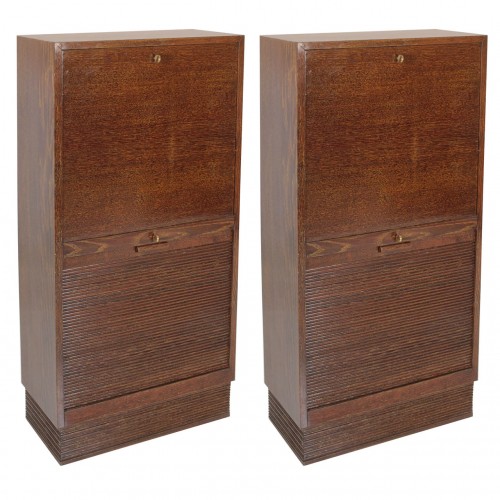Product Description
Pierre-Emile Legrain (attr.) Pair of French Art Deco drop and roll front cabinets c. 1927



PIERRE-EMILE LEGRAIN attr. (1889-1929) France
Matching Cabinets (pair) c. 1927
Golden cerused oak, roll-front and drop front doors,
original brass keys, reeded base
Provenance: Felix Marcilhac, Paris
For more information on Legrain see: Pierre-Emile Legrain 1889-1929 (Paris: exh. cat. Galerie Jacques de Vos,1996); Union des Artistes Modernes, Arlette Barré-Despond (Paris: Editions du Regard, 1986) 119-120.
H: 50 1/2 ” x W: 23 1/2” x D: 11 1/2”
The Art Deco movement centered in early 20th-century Paris sought to bridge the transition from academic art and craftsmanship to modern art and industrial production. Regarded by some as one of its founders, Pierre-Emile Legrain (1889-1929) worked at a time of great ferment in art, as well as in society. Legrain’s curiosity and receptiveness to these changes led him to adapt forms, materials and techniques from other cultures.
Legrain created two distinct bodies of work: an assemblage of approximately 1,200 bookbinding designs and a much smaller production of furniture made for couturiers in the French fashion trade. Both artistic endeavors shared fine craftsmanship, masterful use of rare and expensive materials, unusual combinations of textures and surfaces, and spare, geometrical forms. Nearly all of his creations were one-of-a-kind.
Pierre-Emile Legrain (attr.) Pair of French Art Deco drop and roll front cabinets c. 1927
Leonard Wyburd UK
Liberty & Company London
Four-legged Thebes stool circa 1890-95. Oak with highly figured grain, concave slat seat, turned details.
Marks: 4 (impressed on underside)
This design was registered by Liberty & Co. in 1884.
Related Liberty & Co. stools illustrated: Liberty’s 1875-1975 : An Exhibition to Mark the Firm’s Centenary (London: Victoria & Albert Museum, 1975) p. 35, illustr. C1, Liberty Design, 1874-1914 , Barbara Morris (London: Octopus Publishing Group:, 1989) p. 103; Egyptomania: Egypt in Western Art, 1730-1930 (Paris: Éditions de la Réunion des Musées Nationaux and Ottawa: National Gallery of Canada, 1994), pp. 465-66.
H: 15″ x D: 17″ x W: 17″
One of the driving influences of the Aesthetic Movement of the late 19th century was an informed interest in authentic ancient designs inspired by recent archaeological discoveries. Both the three and four-legged Thebes stool were inspired by actual furniture and wall paintings unearthed from royal tombs in the ancient Egyptian city for which they are named. Leonard Wyburd, who was one of the principal designers for Liberty, patented his designs for the Thebes stools in 1884. Liberty & Co. continued to make the popular stools into the early 1900’s.
